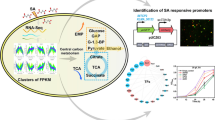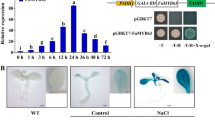Abstract
To determine whether the exogenous expression of glutathione reductase (GR) from Brassica rapa subsp. pekinensis (BrGR) can reduce the deleterious effects of unfavorable conditions, we constructed a transgenic Saccharomyces cerevisiae strain bearing the GR gene cloned into the yeast expression vector, pVTU260. BrGR expression was confirmed by semi reverse transcriptase-polymerase chain reaction (RT-PCR) analysis, immunoblotting analysis and an enzyme assay. Ectopic BrGR-expression improved cellular glutathione (GSH) homeostasis after higher GSH accumulation in the transgenic yeast than in the wild-type yeast under H2O2-induced oxidative stress. The BrGR-expressing yeast strain induced the activation of metabolic enzymes (Hxt, G6PDH, GAPDH and Ald), antioxidant systems (Gpx, Trx2, Trx3, Trr1, Tsa1 and porin) and molecular chaperones (Hsp104, Hsp90, Hsp70, Hsp42, Hsp26, Grp, Sti1 and Zpr1), which led to lower oxidative protein damage after a reduction in the level of cellular ROS in the BrGR-expressing yeast strain exposed to H2O2 than in the wild-type yeast strain. BrGR-expression increased the ability to adapt and recover from H2O2-induced oxidative stress and various stressors, including heat shock, menadione, tert-butyl hydroperoxide, heavy metals, sodium dodecyl sulfate, ethanol and NaCl, but did not affect fermentation capacity. These results suggest that ectopic BrGR expression confers acquired tolerance by improving proteostasis and redox homeostasis through co-activation of various cell rescue proteins against ROS-induced oxidative stress in yeast cells.









Similar content being viewed by others
References
Cardoso LA, Ferreira ST, Hermes-Lima M (2008) Reductive inactivation of yeast glutathione reductase by Fe(II) and NADPH. Comp Biochem Physiol A Mol Integr Physiol 151:313–321
Carmel-Harel O, Storz G (2000) Roles of the glutathione- and thioredoxin-dependent reduction systems in the Escherichia coli and Saccharomyces cerevisiae responses to oxidative stress. Annu Rev Microbiol 54:439–461
Costa V, Moradas-Ferreira P (2001) Oxidative stress and signal transduction in Saccharomyces cerevisiae: insights into ageing, apoptosis and diseases. Mol Aspects Med 22:217–246
Deiana L, Carru C, Pes G, Tadolini B (1999) Spectrophotometric measurement of hydroperoxides at increased sensitivity by oxidation of Fe2+ in the presence of xylenol orange. Free Radic Res 31:237–244
Flattery-O’Brien JA, Dawes IW (1998) Hydrogen peroxide causes RAD9-dependent cell cycle arrest in G2 in Saccharomyces cerevisiae whereas menadione causes G1 arrest independent of RAD9 function. J Biol Chem 273:8564–8571
Foyer CH, Halliwell B (1976) The presence of glutathione and glutathione reductase in chloroplasts: a proposed role in ascorbic acid metabolism. Planta 133:21–25
Foyer CH, Souriau N, Perret S, Lelandais M, Kunert KJ, Pruvost C, Jouanin L (1995) Overexpression of glutathione reductase but not glutathione synthetase leads to increases in antioxidant capacity and resistance to photoinhibition in poplar trees. Plant Physiol 109:1047–1057
Francisco M, Cartea ME, Soengas P, Velasco P (2011) Effect of genotype and environmental conditions on health-promoting compounds in Brassica rapa. J Agric Food Chem 59:2421–2431
Gasch AP, Spellman PT, Kao CM, Carmel-Harel O, Eisen MB, Storz G, Botstein D, Brown PO (2000) Genomic expression programs in the response of yeast cells to environmental changes. Mol Biol Cell 11:4241–4257
Gaullier JM, Lafontant P, Valla A, Bazin M, Giraud M, Santus R (1994) Glutathione peroxidase and glutathione reductase activities towards glutathione-derived antioxidants. Biochem Biophys Res Commun 203:1668–1674
Gietz RD, Woods RA (2001) Genetic transformation of yeast. Biotechniques 30:816–820
Gong Y, Kakihara Y, Krogan N, Greenblatt J, Emili A, Zhang Z, Houry WA (2009) An atlas of chaperone-protein interactions in Saccharomyces cerevisiae: implications to protein folding pathways in the cell. Mol Syst Biol 5:275
Grant CM (2001) Role of the glutathione/glutaredoxin and thioredoxin systems in yeast growth and response to stress conditions. Mol Microbiol 39:533–541
Grant CM, Perrone G, Dawes IW (1998) Glutathione and catalase provide overlapping defenses for protection against hydrogen peroxide in the yeast Saccharomyces cerevisiae. Biochem Biophys Res Commun 253:893–898
Guo S, Wharton W, Moseley P, Shi H (2007) Heat shock protein 70 regulates cellular redox status by modulating glutathione-related enzyme activities. Cell Stress Chaperones 12:245–254
Han D, Antunes F, Canali R, Rettori D, Cadenas E (2003) Voltage-dependent anion channels control the release of the superoxide anion from mitochondria to cytosol. J Biol Chem 278:5557–5563
Hartl FU, Hayer-Hartl M (2002) Molecular chaperones in the cytosol: from nascent chain to folded protein. Science 295:1852–1858
Jamieson DJ (1998) Oxidative stress responses of the yeast Saccharomyces cerevisiae. Yeast 14:1511–1527
Kim IS, Shin SY, Kim YS, Kim HY, Yoon HS (2009) Expression of a glutathione reductase from Brassica rapa subsp. pekinensis enhanced cellular redox homeostasis by modulating antioxidant proteins in Escherichia coli. Mol Cells 28:479–487
Kim SJ, Jung HJ, Hyun DH, Park EH, Kim YM, Lim CJ (2010) Glutathione reductase plays an anti-apoptotic role against oxidative stress in human hepatoma cells. Biochimie 92:927–932
Kim IS, Jin I, Yoon HS (2011) Decarbonylated cyclophilin A Cpr1 protein protects Saccharomyces cerevisiae KNU5377Y when exposed to stress induced by menadione. Cell Stress Chaperones 16:1–14
Laemmli UK (1970) Cleavage of structural proteins during the assembly of the head of bacteriophage T4. Nature 227:680–685
Lee H, Jo J, Son D (1998) Molecular cloning and characterization of the gene encoding glutathione reductase in Brassica campestris. Biochim Biophys Acta 1395:309–314
Lee H, Won SH, Lee BH, Park HD, Chung WI, Jo J (2002) Genomic cloning and characterization of glutathione reductase gene from Brassica campestris var. Pekinensis. Mol Cells 13:245–251
Mehlen P, Kretz-Remy C, Preville X, Arrigo AP (1996) Human hsp27, Drosophila hsp27 and human alphaB-crystallin expression-mediated increase in glutathione is essential for the protective activity of these proteins against TNFalpha-induced cell death. EMBO J 15:2695–2706
Mendoza-Cozatl D, Loza-Tavera H, Hernandez-Navarro A, Moreno-Sanchez R (2005) Sulfur assimilation and glutathione metabolism under cadmium stress in yeast, protists and plants. FEMS Microbiol Rev 29:653–671
Mockett RJ, Sohal RS, Orr WC (1999) Overexpression of glutathione reductase extends survival in transgenic Drosophila melanogaster under hyperoxia but not normoxia. FASEB J 13:1733–1742
Pereira MD, Eleutherio EC, Panek AD (2001) Acquisition of tolerance against oxidative damage in Saccharomyces cerevisiae. BMC Microbiol 1:11
Schmitt ME, Brown TA, Trumpower BL (1990) A rapid and simple method for preparation of RNA from Saccharomyces cerevisiae. Nucleic Acids Res 18:3091–3092
Sebollela A, Louzada PR, Sola-Penna M, Sarone-Williams V, Coelho-Sampaio T, Ferreira ST (2004) Inhibition of yeast glutathione reductase by trehalose: possible implications in yeast survival and recovery from stress. Int J Biochem Cell Biol 36:900–908
Tan SX, Teo M, Lam YT, Dawes IW, Perrone GG (2009) Cu, Zn superoxide dismutase and NADP(H) homeostasis are required for tolerance of endoplasmic reticulum stress in Saccharomyces cerevisiae. Mol Biol Cell 20:1493–1508
Tan SX, Greetham D, Raeth S, Grant CM, Dawes IW, Perrone GG (2010) The thioredoxin–thioredoxin reductase system can function in vivo as an alternative system to reduce oxidized glutathione in Saccharomyces cerevisiae. J Biol Chem 285:6118–6126
Toledano MB, Delauay A, Biteau B, Spector D, Azevedo D (2003) Oxidative stress responses in yeast. Springer, Berlin
Tucker CL, Fields S (2004) Quantitative genome-wide analysis of yeast deletion strain sensitivities to oxidative and chemical stress. Comp Funct Genomics 5:216–224
Wenzel TJ, Teunissen AW, de Steensma HY (1995) PDA1 mRNA: a standard for quantitation of mRNA in Saccharomyces cerevisiae superior to ACT1 mRNA. Nucleic Acids Res 23:883–884
Wheeler GL, Grant CM (2004) Regulation of redox homeostasis in the yeast Saccharomyces cerevisiae. Physiol Plant 120:12–20
Yoon HS, Lee IA, Lee H, Lee BH, Jo J (2005) Overexpression of a eukaryotic glutathione reductase gene from Brassica campestris improved resistance to oxidative stress in Escherichia coli. Biochem Biophys Res Commun 326:618–623
Acknowledgments
This work was supported by a grant from the Next-Generation BioGreen21 Program (PJ008115), Rural Development Administration, Republic of Korea.
Author information
Authors and Affiliations
Corresponding author
Electronic supplementary material
Below is the link to the electronic supplementary material.
Rights and permissions
About this article
Cite this article
Yoon, HS., Shin, SY., Kim, YS. et al. Glutathione reductase from Brassica rapa affects tolerance and the redox state but not fermentation ability in response to oxidative stress in genetically modified Saccharomyces cerevisiae . World J Microbiol Biotechnol 28, 1901–1915 (2012). https://doi.org/10.1007/s11274-011-0988-8
Received:
Accepted:
Published:
Issue Date:
DOI: https://doi.org/10.1007/s11274-011-0988-8




